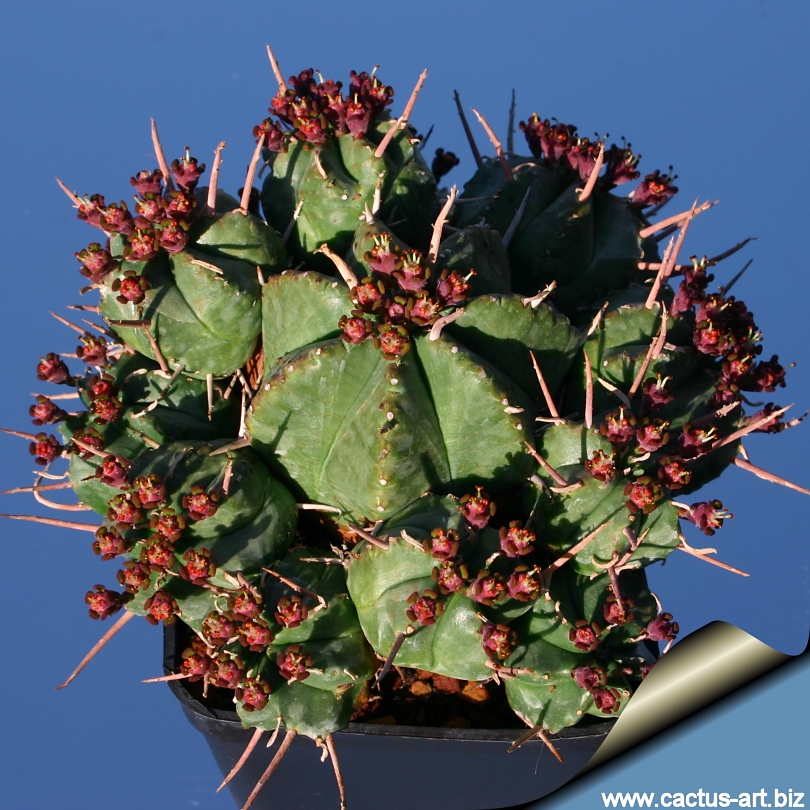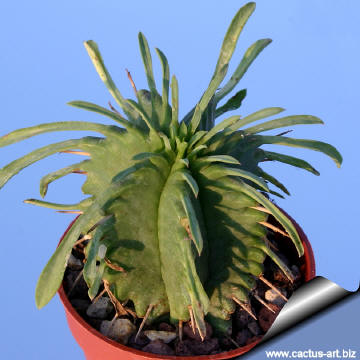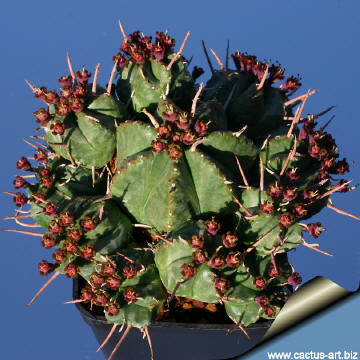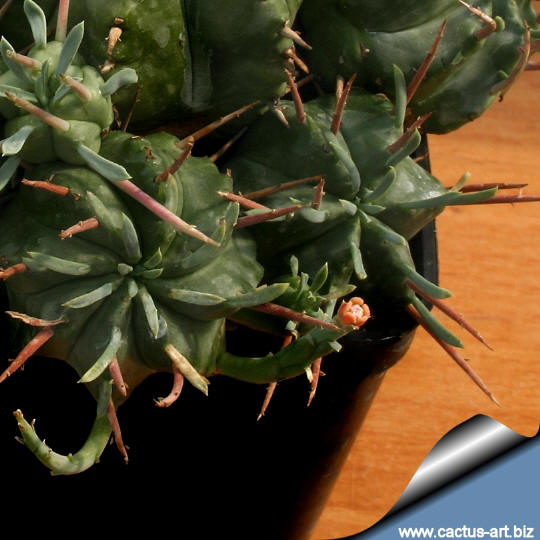|
|
|

Euphorbia pulvinata
This is a beautiful compact species that provides
a magnificent view. Unfortunately these plants are seldom found in
collections. The rounder forms are often very pretty
and appreciated by collectors.
|
|
Description: Low-growing clumping globular succulent, that in
nature forms impressive giant
pulvini (cushions) up to three meters in height, composed of several
thousands of little heads of just four to five centimetres in diameter.
Some very old plants must have 40.000 heads or more!!!
Stem: Short, globose to columnar. The most common form in
cultivation (depicted in this page) has compact fat globular heads that
seldom exceed
30 cm in height.
Spines: White to purple (depending on the season)
Note: Euphorbia pulvinata has a large area of
distribution, and is a very variable species. The plants from the
northern distribution area differ clearly from those of the south: one
forming dense cushions of up to 30 cm in height, the other with few
stems, up to 1 m high (The small one is the most common in cultivation).
The difference between populations is the frequency of the appearance in
which these forms occur. So it can happen that two individuals of two
different populations can look very similar and also, two plants of the
same population can look very different. However when you are looking at
the whole population, you can see the difference of one population from
another.
|
|

In the wild, Euphorbia pulvinata will form huge
clumps with up to 40.000 heads (or more) which resemble giant green
termite mounds. |

|
|
|
 |
 |
|


Advertising
|
|
|
|
|
Family: Euphorbiaceae
Scientific name:
Euphorbia pulvinata Marloth
Introduction:
Euphorbia pulvinata belongs to a group of plants, together with
the closely related species
Euphorbia ferox and Euphorbia aggregata,
which can be recognised by their striking growing-shape. They consist
mostly of compact, multiple branched and heavily thorny cushions. These
species are closely related, and for an outsider it's very difficult to
distinguish them. There are differences, though.
Origin: South Africa (Natal), Lesotho It is located from the
south at Queenstown, to the north, through and along Lesotho, the
Drakensbergen, Free State and kwazulu Natal up to Zoutpansbergen
in the Northern Province.
Habitat: Euphorbia ferox
grows in areas with a lot of rain, up to 1000 mm per year, and even with
snow sometimes.
At some locations it is the most dominant vegetation,
often growing together with Euphorbia esculenta and Euphorbia mammillaris.
Conservation status: Listed in
CITES appendix 2.
Common Name: Pincushion Euphorbia
|
|
|
|

Flowers.

Cultivation: It is a pretty easy species.
It grows well in a very
draining mineral potting substrate, but it isn't picky about soil.
The
area where this plant is native receives rain both in
winter and
summer, so it can be watered moderately all year around (except in the
coldest month of the winter as it rots easily, especially if over wet ).
During the summer, they enjoy average feeding and watering. Mature
healthy plants are tough, and can also be grown out of doors where frost
is not too severe. When dormant, the plant is very cold tolerant (down
to nearly -9° C or less), but when left out it is more sensitive to
frost. They do need a lot of light to keep their compact growth-form,
but different clones vary in their tolerance of full sunshine.
Propagation: It is
propagated by cuttings (It branchs enthusiastically, and offsets are
readily available). If you remove an offset, remember to let it dry for a
week or so, letting the wound heal (cuttings planted too soon easily rot
before they can grow roots). It is better to wash the cut to remove the
latex.
Warning: As with all other Euphorbias, when a plant gets damaged it
exudes a thick white milky sap known as latex. This latex is poisonous
and may irritate skin, so pay extreme attention not to get any in your
eyes or mouth.
Cultivated plants must be handled carefully. |
|